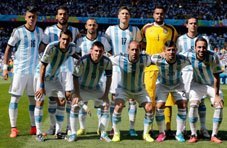In Argentina, soccer has become a part of the collective life of society, and watching soccer matches has even become a tourist attraction. Soccer is the sport with most spectators in the country, and the Argentinian national team is prestigious and carries a lot of history. The national squad is known as La Selección or Albicelestes, which alludes to the colours of the kit and the national flag (white and sky blue). Soccer has been introduced in Argentina by a large British community in Buenos Aires in the second half of the 19th century.
People often say: Argentina’s two greatest passions are tango and soccer. On the same note, some spectacular club rivalries can be seen among Argentinian soccer teams and also fervent fan bases. The most notable rivalry is the one between Boca Juniors and River Plate. There are over 450 registered soccer clubs in Argentina that play in the Argentine Football Association (AFA) league system consisting of 8 leagues, with the highest level of club soccer being the Primera División or Superliga Argentina.
3 Facts about the Team History
- Copa América Success: The Copa América or the South American Football Championship is an international men's soccer tournament in which the national teams of South America compete. Argentina’s national team won the tournament 14 times, finished as runners-up 14 times and achieved a third-place finish on four occasions. The country hosted the competition a total of 9 times.
- World Cup Track Record: the Argentina national team has appeared in five FIFA World Cup finals; they have won the trophy twice. The first final they played against Uruguay in 1930 and they lost 4-2. The white and sky blue team won the FIFA World Cup for the first time in 1978 defeating the Netherlands, and they’ve won it for the second time in 1986 defeating West Germany.
- Notable Figures: There have been multiple exceptional soccer players performing for the Argentinian national team over the years such as Gabriel Batisuta and Juan Roman Riquelme, but the two most notable figures are Diego Maradona and Lionel Messi. Diego Armando Maradona Franco was an advanced playmaker with outstanding dribbling skills, excellent ball control, speed and reflexes. He is regarded by many as one of the greatest soccer players of all time and was appointed a joint FIFA Player of the 20th Century with Pelé. As a talented sportsman as he was, Maradona was nicknamed ’El Pibe de Oro’ (The Golden Boy). Lionel Messi is the star of today’s Argentinian soccer, making his national team debut as a prodigy. He is his country's all-time leading goalscorer with 61 goals and a multiple record holder for various achievements. Compared with Diego Maradona for being a diminutive, left-footed dribbler, he was named the legendary player’s successor by Maradona himself.
3 Fun Facts about the Country
- Mate: The national drink of Argentina is called ‘mate’; it is made from the yerba mate, from young leaves of an evergreen tree from the holly family and is drunk as a tea beverage from a gourd of a bowl through a bombilla (metal straw).
- Movies: The very first animated film in the world was created by Quirino Cristiani, and Argentinian. It was called ‘El Apostol’ and it was made in 1917. It was was 70 minutes long and had over 58,000 frames. Argentina has the highest rates of movie viewing in the world per capita. Also, Argentina is the only Latin American country to have won an Academy Award aka the Oscar - twice - for La Historia Oficial in 1985 and in 2010 for El Secreto de Sus Ojos.
- European Heritage: A major portion of the Argentinian population is of European descent; in fact, as many as 95% of people residing in Argentina originate from Europeans. Argentina’s capital Buenos Aires is often referred to as ‘the Paris of South America’ because of the notable its European influences.




